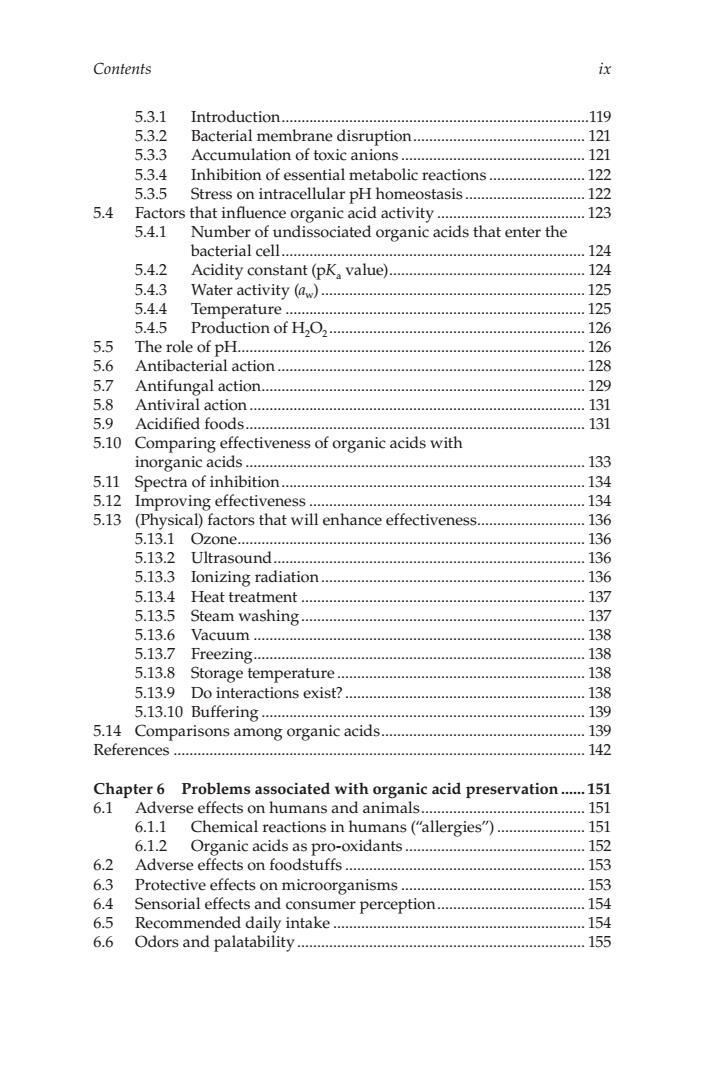正在加载图片...

Contents 521 Introduction. 119 537 Bacterial m 121 5.33 mal membra toxic anions 53.4 Inhibition of esse ntial metabolic reactions. 53.5 Stress on intracellular pH homeostasis... 122 5.4 Factors that influence organic acid activity... 123 5.4.1 Number of undissociated organic acids that enter the bacterial cell...... 124 5.4.2 Acidity constant (pK value)124 543 Water activity (a). 125 544 Temperature 125 545 Production of H,O, 55 The role of pH... 126 5.6 Antibacterial action. akm 129 13 Acidified foods 31 Comparing effectiveness of organic acids with inorganic acids 133 5.11 Spectra of inhibition...... 1 5.12 Improving effectiveness... 134 5.13 (Physical)factors that will enhance effectiveness......................136 5.13.1 Ozone..... 136 5.13.2 Ultrasound. 5.13.3 Ionizing radiation 5.134 Heat treatment 137 5135 washing. 5136 138 5137 Freezi 138 rage ter mperature Do interactions exist? 5.13.10 Buffering........ 5.14 Comparisons among organic acids 139 References 142 Chapter 6 Problems associated with organic acid preservation......151 6.1 Adverse effects on humans and animals.. 151 611 Chemical reactions in humans("allergies"). 151 6.1.2 Organic acids as pro-oxidants 152 6.2 Adverse effects on foodstuffs 153 Protectiv microorganisms 153 nsorial eff 154 R ended daily intakener perception 154 Odors and palatability.... 155Contents ix 5.3.1 Introduction.............................................................................119 5.3.2 Bacterial membrane disruption........................................... 121 5.3.3 Accumulation of toxic anions .............................................. 121 5.3.4 Inhibition of essential metabolic reactions ........................ 122 5.3.5 Stress on intracellular pH homeostasis .............................. 122 5.4 Factors that influence organic acid activity ..................................... 123 5.4.1 Number of undissociated organic acids that enter the bacterial cell............................................................................ 124 5.4.2 Acidity constant (pKa value)................................................. 124 5.4.3 Water activity (aw).................................................................. 125 5.4.4 Temperature ........................................................................... 125 5.4.5 Production of H2O2 ................................................................ 126 5.5 The role of pH....................................................................................... 126 5.6 Antibacterial action ............................................................................. 128 5.7 Antifungal action................................................................................. 129 5.8 Antiviral action.................................................................................... 131 5.9 Acidified foods..................................................................................... 131 5.10 Comparing effectiveness of organic acids with inorganic acids ..................................................................................... 133 5.11 Spectra of inhibition............................................................................ 134 5.12 Improving effectiveness ..................................................................... 134 5.13 (Physical) factors that will enhance effectiveness........................... 136 5.13.1 Ozone....................................................................................... 136 5.13.2 Ultrasound.............................................................................. 136 5.13.3 Ionizing radiation.................................................................. 136 5.13.4 Heat treatment ....................................................................... 137 5.13.5 Steam washing....................................................................... 137 5.13.6 Vacuum ................................................................................... 138 5.13.7 Freezing................................................................................... 138 5.13.8 Storage temperature .............................................................. 138 5.13.9 Do interactions exist? ............................................................ 138 5.13.10 Buffering ................................................................................. 139 5.14 Comparisons among organic acids................................................... 139 References ....................................................................................................... 142 Chapter Problems associated with organic acid preservation 6 ...... 151 6.1 Adverse effects on humans and animals......................................... 151 6.1.1 Chemical reactions in humans (“allergies”)...................... 151 6.1.2 Organic acids as pro-oxidants ............................................. 152 6.2 Adverse effects on foodstuffs ............................................................ 153 6.3 Protective effects on microorganisms .............................................. 153 6.4 Sensorial effects and consumer perception..................................... 154 6.5 Recommended daily intake ............................................................... 154 6.6 Odors and palatability ........................................................................ 155